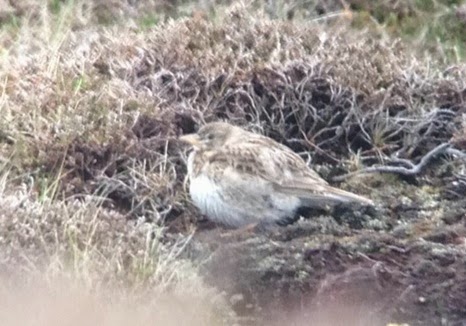 |
| Honk. The first Canada Goose on Fair Isle since 2011 was presumably an overshoot from the UK rather than North America. |
The Caspian
Stonechat remained throughout (having made its way back to Upper Leogh), the
male Western Subalpine Warbler remained at Burkle to 21st at least, the
female Western Subalpine Warbler was still present at the Obs, there were
Bluethroats at the Mast (22nd-23rd, found by Lark
twitchers from down the island!) and at Shirva (21st-24th),
a Common Rosefinch appeared at the Obs on 21st then roamed the
island for a couple of days before returning to the Obs until the 24th
at least (it was a singing first-summer male, missing its tertials on the left
wing) and the Kumlien’s Gull was still in the South Harbour area until 24thm
although it was looking increasingly unhappy with the world.
 |
| The Common Rosefinch's most regular song is what appears to be a good copy of a Willow Warbler! |
In Fair Isle
terms though, none of the species above were as rare as the Cormorant at Easter
Lother on 24th, which photographs proved was a sinensis ‘Continental’ Cormorant, the first record of this
subspecies for Fair Isle.
The same day saw another potential first for the
island, when a bumblebee photographed in the Obs garden appeared to be a
White-tailed Bumblebee, perhaps solving the recent bee mystery… |
| The Bumblebee in the Obs garden. Its tail certainly looks white, but bees aren't necessarily that simple. Any thoughts gratefully received. Photo: Ciaran Hatsell. |
Northerly
spells gave way to easterly winds and fog during the period, eventually clearing
slightly on the afternoon of 24th and there were still a reasonable
number of interesting bits and bobs coming through, although being lost in the
fog prevented more from finding us.
Other new
species for the year included Swift (four on the 21st with smaller
numbers after), Shoveler (a male from 23rd) and Storm Petrel (two
seen from the Good Shepherd on 24th), with other scarcer migrants
including Wood Sandpiper (20th), Lesser Redpoll (23rd and
24th, amongst a small turnover of Mealy Redpolls, which saw a peak
of 11) and Cuckoo (20th). Numbers of commoner species were generally
unremarkable, with a few hirundines including peaks of 4 Sand Martin, 27
Swallows and 11 House Martins, a slight increase in warblers on 24th
brought 9 Willow Warbler, Garden Warbler and 2 Lesser Whitethroat along with
Pied Flycatcher (one was also seen on 22nd), Brambling, and peaks of
2 Black Redstart, 8 Spotted Flycatcher and 3 Snow Bunting. |
| Siskins have been on the move in small numbers amongst a trickle of northern finches. |
A late
Pink-footed Goose was present from 22nd, whilst a slight rise in
waders included peaks of 56 Dunlin, 5 Sanderling, 24 Purple Sandpiper, 11 Whimbrel
and a Common Sandpiper, although these were put into the shade by a remarkable passage of Ringed Plovers which saw numbers peak at 103 on 24th.
A whole week
of easterly wind is forecast again, but surely we must be running out of good
birds soon…


Hi David, interesting picture of the bumblebee. Accounting for the angle of the shot, I think this may be B. lucorum. Happy to be corrected by entomologists. This may be helpful: http://www.nhm.ac.uk/research-curation/research/projects/bombus/_key_colour_british/ck_widespread.html#lucorum
ReplyDelete